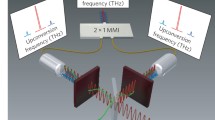Abstract—A theoretical analysis of various single-sideband modulation formats used in fiber-optic communication lines with an external electrooptical two-electrode Mach–Zehnder modulator for generating optical signals resistant to dispersive power degradation has been performed. A family of new single-sideband modulation formats is presented, the features of their use, advantages, and disadvantages are considered. A decrease in nonlinear distortions of signals during their transportation through dispersive optical fiber is assumed.


Similar content being viewed by others
REFERENCES
G. H. Smith, D. Novak, and Z. Ahmed, Electron. Lett. 33, 74 (1997).
R. Hui, Introduction to Fiber-Optic Communications (Academic, New York, 2020).
M. Xue, Sh. Pan, and Y. Zhao, J. Lightwave Technology 32, 3317 (2014).
Y. Yin, T. Lin, S. Zhao, et al., Int. J. Phys. & Math. Sci. 12 (10), 202 (2018).
S. X. Chew, D. Huang, L. Li, et al., Opt. Express 27, 14798 (2019).
Zh. Guo, J. Ma, Sh. Huang, and X. Gao, Fiber & Integrated Opt. 38, 208 (2019).
M. Yasir and P. Savi, Micromachines 11, 600 (2020).
J. Zhang, Li T. Tianyi, R. Kokkoniemi, et al., AIP Advances 10, 065128 (2020).
G. P. Agrawal, Nonlinear Fiber Optics (Academic, New York, 2013).
V. V. Shcherbakov, A. F. Solodkov, and A. A. Zadernovskii, Radioelektron. Nanosist. Inform. Tekhnologii (RENSIT) 8, 9 (2016).
W. Liu and J. Yao, Opt. Lett. 39, 922 (2014).
M. S. B. Cunha, R. N. Da Silva, and R. M. Borges, and S. A. Arismar Cerqueira, in Proc. Conf. SBMO/IEEE MTT-S Int. Microwave and Optoelectronics Conf. (IMOC), Aguas De Lindoia, Aug. 27–30, 2017 (IEEE, New York, 2017), p. 8121054.
H. Bateman and A. Erdélyi, Higher Transcendental Functions (R. E. Krieger Pub. Co., Malabar, Fla., 1981; Nauka, Moscow, 1974), Vol. 2.
M. Abramowitz and I. A. Stegun, Handbook of Mathematical Function (National Bureau of Standards, Applied Mathematics Series, Vol. 55, 1972; Nauka, Moscow, 1979).
Author information
Authors and Affiliations
Corresponding authors
APPENDIX
APPENDIX
In fiber-optic communication lines, the stage of transporting light signals through an optical fiber is described in terms of classical electromagnetic waves, i.e., in terms of the strengths of electric and magnetic fields. Registration of the incoming signals with the help of a photodetector is based on the phenomenon of the photoelectric effect and returns us to the photon interpretation and the need to determine the intensity of light. Thus, the optical signal detector is quadratic with respect to the electric field strength of the light wave. Determination of the spectral components of light intensity (9) based on knowledge of the spectral composition of corresponding electromagnetic wave (6) leads to the calculation of series of type (10). Such calculations are usually performed using the Graf summation theorem for Bessel functions. However, the traditional presentation of this theorem, available in well-known monographs [13, 14] devoted to Bessel functions, leads to expressions that are rather difficult to directly apply for the purposes of analyzing the transmission of light signals in fiber-optic communication lines. In this Appendix, we will reformulate and prove Graf’s theorem in terms most suitable for such analytical calculations.
We start with the well-known integral representation of the Bessel function
Change of variables \(\theta = \psi + \gamma \), \(d\theta = d\psi \) leads (A.1) to form
Next, we multiply both sides of equality \({{z}_{1}}\exp (i\alpha ) + {{z}_{2}}\exp (i\beta )\) \( = {{z}_{3}}\exp (i\gamma )\) by \(\exp (i\psi )\) and equate the imaginary parts of the resulting expression. Then, we get
Substituting this into formula (A.2), we arrive at relation
Now using the Jacobi–Anger decomposition, we write
and substitute in (A.3). Then, we get
Change of variables \(\psi = \chi - \gamma \), \(d\psi = d\chi \) in integral (A.5) gives
where we used equality
and introduced Kronecker symbol \({{\delta }_{{mn}}}\) equal to 1 at m = n and 0 otherwise. As a result, we obtain a convenient formula for summing series:
where complex numbers \({{z}_{1}}\exp (i\alpha )\), \({{z}_{2}}\exp (i\beta )\), and \({{z}_{3}}\exp (i\gamma )\) are related by relationship \({{z}_{1}}\exp (i\alpha ) + \) \({{z}_{2}}\exp (i\beta )\) \( = {{z}_{3}}\exp (i\gamma )\). This statement is the essence of Graf’s theorem. Equivalent statement (10) used in this article to calculate the intensity of the light signal is obtained from (A.8) by replacing index m by –m .
The formulations of Graf’s theorem on the summation of series of Bessel functions, given in well-known textbooks [13, 14], are obtained directly from (A.8) as a special case for \(\alpha = 0\).
Rights and permissions
About this article
Cite this article
Zadernovskii, A.A., Shcherbakov, V.V. & Solodkov, A.F. Extended Single-Sideband Light Intensity Modulation Formats. J. Commun. Technol. Electron. 66, 1053–1057 (2021). https://doi.org/10.1134/S1064226921090187
Received:
Revised:
Accepted:
Published:
Issue Date:
DOI: https://doi.org/10.1134/S1064226921090187




